The US American charity Breast Cancer Research Foundation (BCRF) proudly lists its heroes, with profile pictures:
“We fund the best and brightest researchers in the world. Our nearly 275 grantees come from all disciplines of science and are given the creativity and intellectual freedom to pursue the most promising research. Each has an ultimate goal: to prevent and find a cure for breast cancer. Get to know our gamechangers.”
The pseudonymous image integrity sleuth Clare Francis specialises since many years on finding data manipualtion in cancer research, and now suggested I write about some of the scientists funded by BCRF. I think it is a good idea to honour these wizards of the Photoshop, the wise men whose cancer research brought them tremendous fame, money and power. But what did it objectively bring to cancer patients, like the many women suffering and dying of breast cancer? Will h-index and impact factor ever be truly able help them, or can we maybe place higher quality expectations on biomedical research?
Stuart Aaronson
At the BCRF website, the faces of the genius minds who help women suffering from breast cancer are arranged alphabetically. This is why it starts with Stuart Aaronson, founding chair and professor at Icahn Medical School at Mount Sinai, New York, which is hopefully not meant as a fair warning how exactly BCRF wishes to see breast cancer being treated: with Photoshop.
Aaronson namely has 20 papers flagged on PubPeer, of which 3 have been retracted, and 2 more received an expression of concern (see here). All co-authored with his protege, the Harvard professor and animal abuser Sam W Lee, who in turn boasts in total 5 retractions. Now you might say: Aaronson is just a victim of Lee’s naughtiness here? This paper from Aaronson lab for example has no Lee on it:
SK Mungamuri , RF Qiao , S Yao , JJ Manfredi , W Gu , SA Aaronson USP7 Enforces Heterochromatinization of p53 Target Promoters by Protecting SUV39H1 from MDM2-Mediated Degradation Cell Reports (2016) – doi: 10.1016/j.celrep.2016.02.049
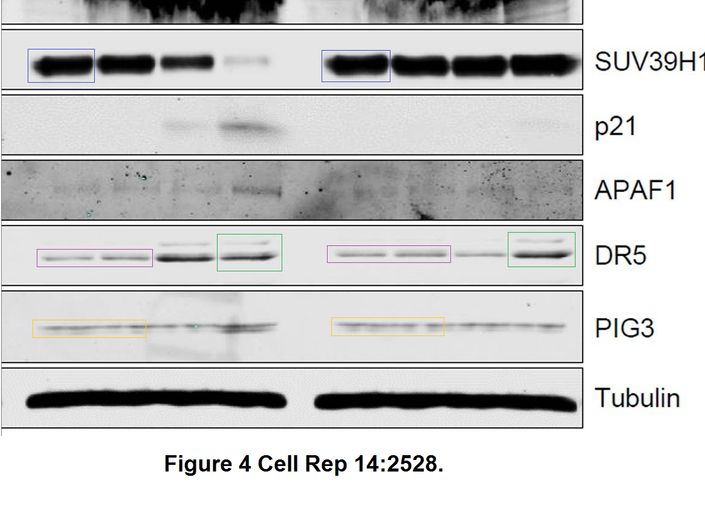
It looks as if someone was cloning gel bands here, but Professor Aaronson was so busy curing cancer that he until now had no time to have a look at these 3 year old PubPeer concerns. Including this one:
A Bafico, G Liu , L Goldin , V Harris , SA Aaronson An autocrine mechanism for constitutive Wnt pathway activation in human cancer cells Cancer Cell (2004) doi: 10.1016/j.ccr.2004.09.032
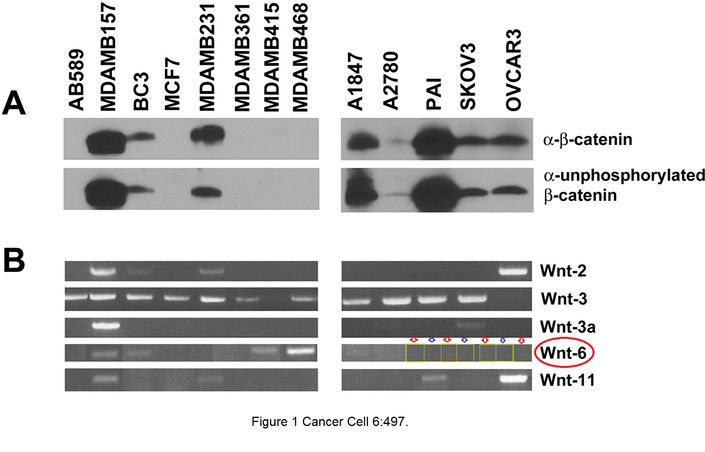
Someone did not like the RT-PCR results in Figure 1B, and replaced the Wnt-6 signal with patches of empty background. Does Cancer Cell care? Are you serious? They love such stuff.
For his attitude to research integrity, Aaronson was awarded with “the Distinguished Service Medal from the U.S. Public Health Service, the AACR Award for Outstanding Achievement in Cancer Research, and the Paul Erhlich [sic!] Prize from Germany.”
Michael Andreeff
Next in this list and still under letter A is Michael Andreeff, a German-born professor at MD Anderson at Houston, Texas. Andreeff has 27 papers on PubPeer, but that is nothing special for an MD Anderson cancer researcher. The clinical institution seems to actively encourage data manipulation and readily takes measures against whistleblowers, in order to make even more money with impactful cancer research while avoiding scaring off mistrustful patients.
Andreeff’s papers are prone to duplications, but also this scientist is too busy curing cancer to bother. Like this here:
BZ Carter , M Milella , DC Altieri , M Andreeff Cytokine-regulated expression of survivin in myeloid leukemia Blood (2001) doi: 10.1182/blood.v97.9.2784
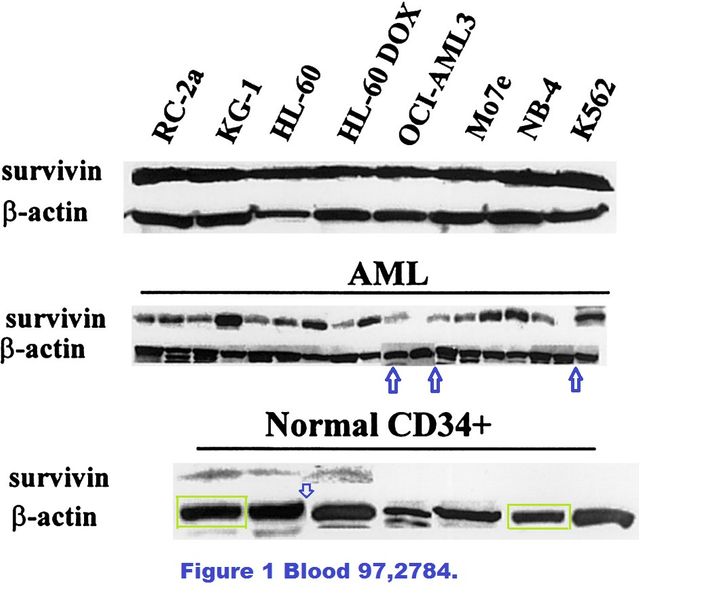
Loading controls are so unimportant that it is actually the due right of every important scientist to play with them in Photoshop. They are the doodle area of a paper, since apparently nobody minds what the scientists draw there. Certainly not the journal Blood, they don’t mind anything at all. Many of Andreeff’s PubPeer criticised papers were coauthored by another MD Anderson cancer wizard, Marina Konopleva. She is probably just as not responsible for the content of her papers as Andreeff is. Like this here:
X Ling , E Spaeth , Y Chen , Y Shi , W Zhang , W Schober , N Hail , M Konopleva , M Andreef The CXCR4 antagonist AMD3465 regulates oncogenic signaling and invasiveness in vitro and prevents breast cancer growth and metastasis in vivo PLoS ONE (2013) doi: 10.1371/journal.pone.0058426
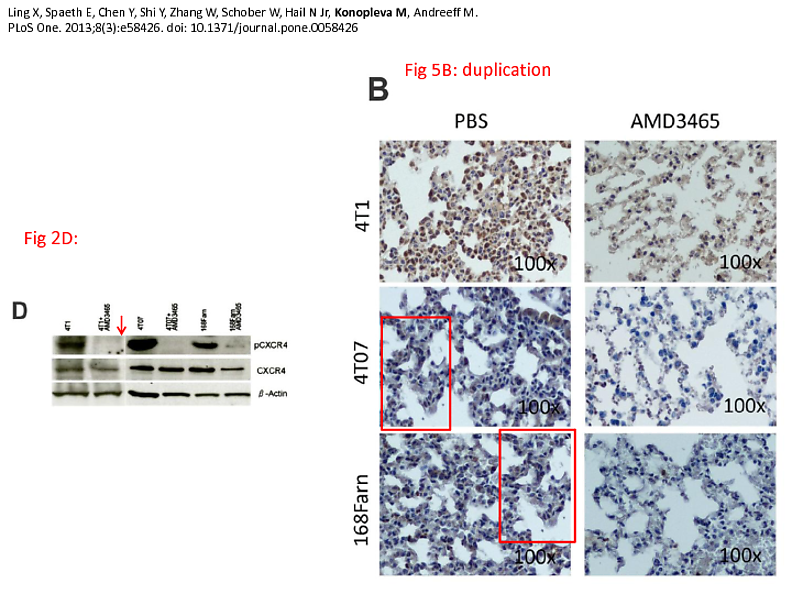
It is not like the sins of the past are over. Quite the opposite, now even whole mice joined the Photoshop game apparently:
VL Battula , PM. Le , JC. Sun , K Nguyen , B Yuan , X Zhou , S Sonnylal , T McQueen , V Ruvolo , KA. Michel , X Ling , R Jacamo , E Shpall , Z Wang , A Rao , G Al-Atrash , M Konopleva , RE Davis , MA. Harrington , CW. Cahill , C Bueso-Ramos, M Andreeff AML-induced osteogenic differentiation in mesenchymal stromal cells supports leukemia growth JCI Insight (2017)
doi: 10.1172/jci.insight.90036
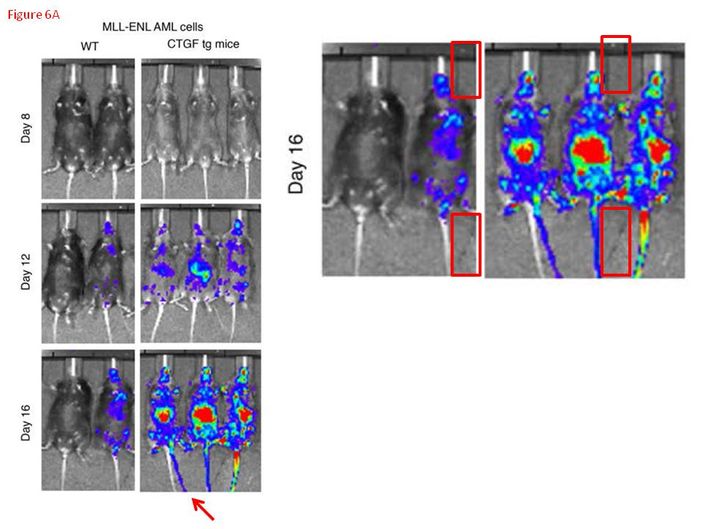
Still under A is Alan Ashworth, originally from England. You can read about his Photoshop achievements in my earlier article, this wizard of breast cancer research is definitely very dedicated to women’s issues. So much that he left ICR London and moved to UC San Francisco to do his BCRF-funded breast cancer research.
Lewis Cantley
Moving back to New York and on to another great man of cancer research, Lewis Cantley, director of the Cancer Center of Weill Cornell Medical College. Cantley has 25 papers on PubPeer, which visualise his contribution to the “Stand up to Cancer” initiative. A lot of PubPeer criticism is about gel splicing, which counter-critics explain was quasi-legal back then. Like this here:
SM Brachmann , CM Yballe , M Innocenti , JA Deane , DA Fruman , SM Thomas , LC Cantley Role of phosphoinositide 3-kinase regulatory isoforms in development and actin rearrangement Molecular and Cellular Biology (2005) doi: 10.1128/mcb.25.7.2593-2606.2005

Apparently, there were times in biomedical sciences, where scientists assembled a Frankenstein picture of a gel in Photoshop from various bits and pieces, masked the splicing traces, and completed the figure with some “library” loading control they found somewhere in the drawer. Maybe that is why we haven’t moved much cancer therapy-wise in those decades, because of such attitude to research? Of course Cantley’s papers have other issues, too:
BM. Emerling , CH. Benes , G Poulogiannis , EL. Bell , K Courtney , H Liu , R Choo-Wing , G Bellinger , KS. Tsukazawa , V Brown , S Signoretti , SP. Soltoff , LC. Cantley Identification of CDCP1 as a hypoxia-inducible factor 2α (HIF-2α) target gene that is associated with survival in clear cell renal cell carcinoma patients Proceedings of the National Academy of Sciences (2013) doi: 10.1073/pnas.1222435110
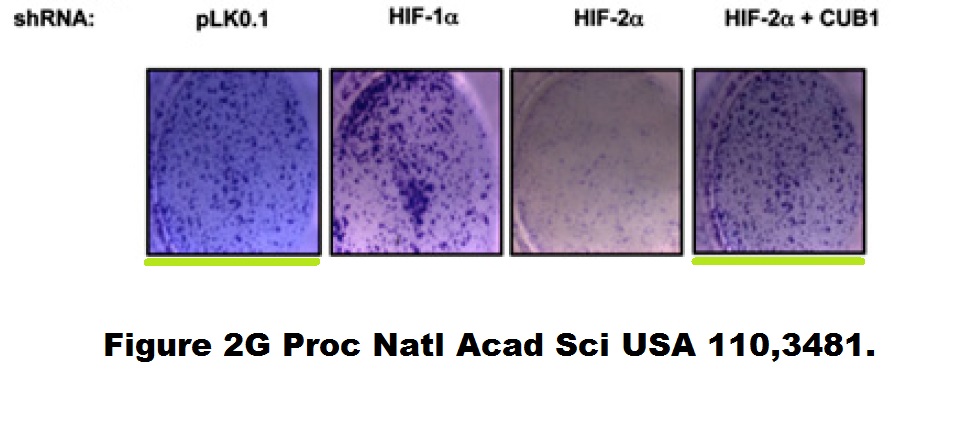
How does this happen accidentally? Copy-paste image, shrink it slightly, change colour, all inadvertently and conclusions not affected? Here another example of an innocent mistake:
KA Lamia, OD Peroni , YB Kim , LE Rameh , BB Kahn , LC Cantley Increased insulin sensitivity and reduced adiposity in phosphatidylinositol 5-phosphate 4-kinase beta-/- mice Molecular and Cellular Biology (2004) doi: 10.1128/mcb.24.11.5080-5087.2004
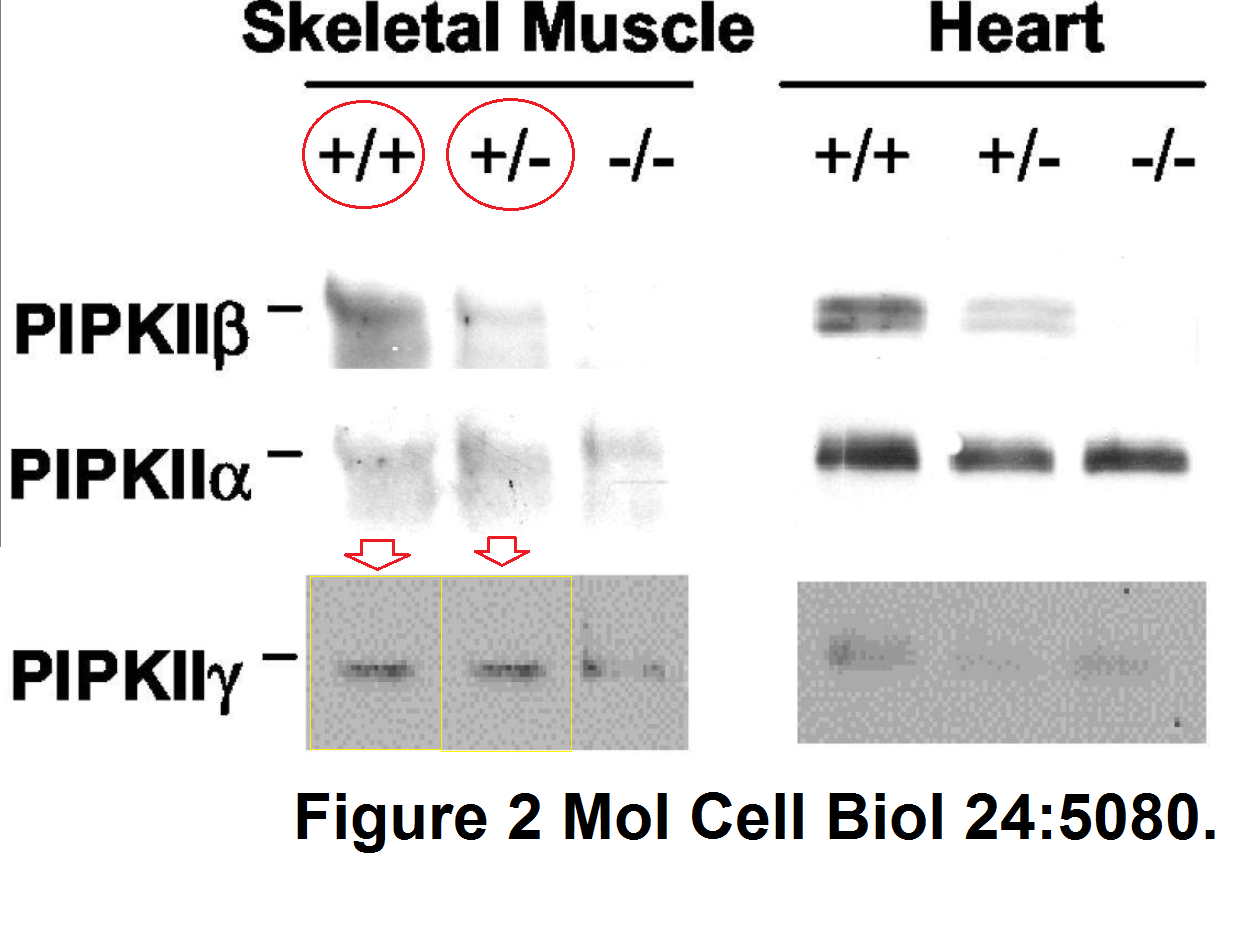
It seems, a band was somehow duplicated. The first author (now Scripps professor) Katja Lamia however dismissed the concerns with
“I can try to find the originals but I probably left them with the Cantley lab, who have since moved, so I doubt that they have been maintained (which I think is reasonable given the passage of more than a decade).“
Professor Cantley could not be arsed. Many of his criticised papers were done in collaboration with another genius of research integrity, the Harvard professor Ronald Kahn (mentioned here). Big men like these cannot be expected to adhere to basic research integrity, as they are busy curing diseases, in their own, mysterious way.
Andrew Dannenberg
Moving on to letter D we encounter a colleague of Cantley’s from Weill Cornell and an absolute star of Photoshop cancer research: Andrew Dannenberg. He now has 10 retractions because the no-nonsense Journal of Biological Chemistry (JBC) recently retracted 9 (NINE!) of his papers in one go. Dannenberg’s lawyer explained to Retraction Watch that their client had absolutely nothing to do with the experiments in the papers from his own lab. Weill Cornell added that they apparently see their professor as the actual whistleblower in this fraud affair. Of course there is more than the 9 retracted JBC papers, here some examples what else Dannenberg published as last author:
A Mohebati , JB Guttenplan , A Kochhar , ZL Zhao , W Kosinska , K Subbaramaiah , AJ Dannenberg Carnosol, a constituent of Zyflamend, inhibits aryl hydrocarbon receptor-mediated activation of CYP1A1 and CYP1B1 transcription and mutagenesis Cancer Prevention Research (2012) doi: 10.1158/1940-6207.capr-12-0002
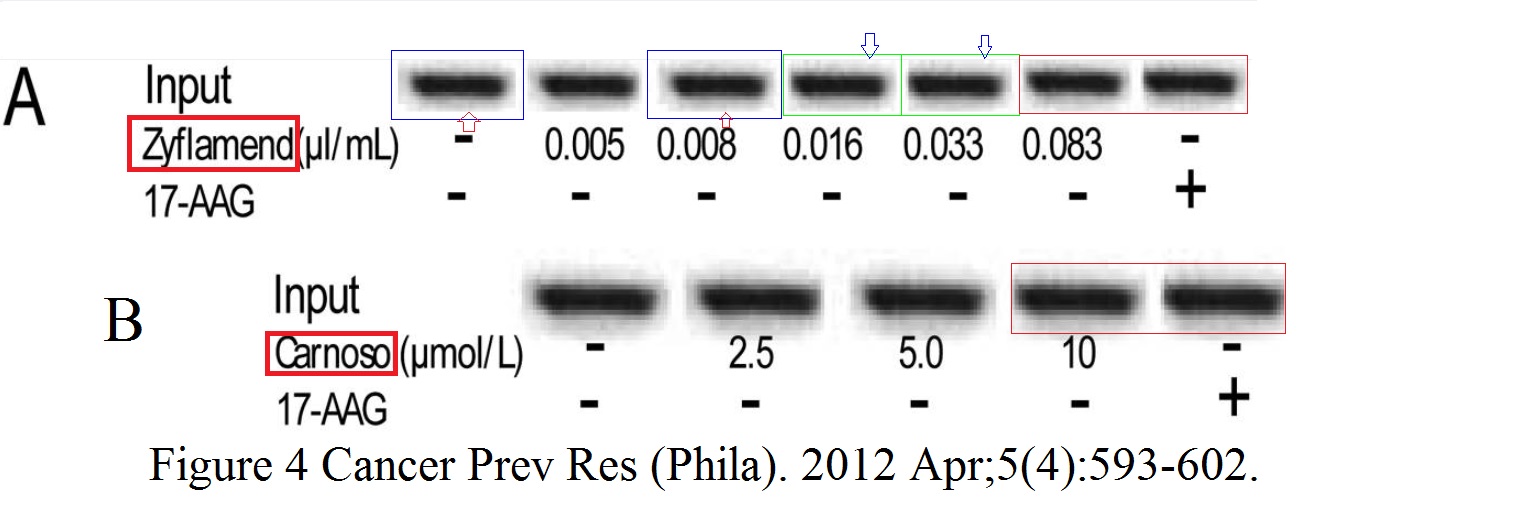
Sure, most problematic Dannenberg papers on PubPeer (there are 24 of them presently) have Kotha Subbaramaiah as coauthor, who is another Weill Cornell Professor deemed as whistleblower. But still, why was it OK for Dannenberg back then to claim full credit for his papers with Subbaramaiah in order to personally get very rich and very powerful, but when trouble arose he suddenly had absolutely nothing to do with these?
How about the following examples, in more papers in the same AACR journal, where Dannenberg just happens to be Senior Editor (so curb your enthusiasm about any possible retractions):
K Subbaramaiah , LR Howe , P Bhardwaj , B Du , C Gravaghi , RK Yantiss , XK Zhou , VA Blaho , T Hla , P Yang , L Kopelovich , CA Hudis , AJ Dannenberg Obesity is associated with inflammation and elevated aromatase expression in the mouse mammary gland Cancer Prevention Research (2011)
doi: 10.1158/1940-6207.capr-10-0381
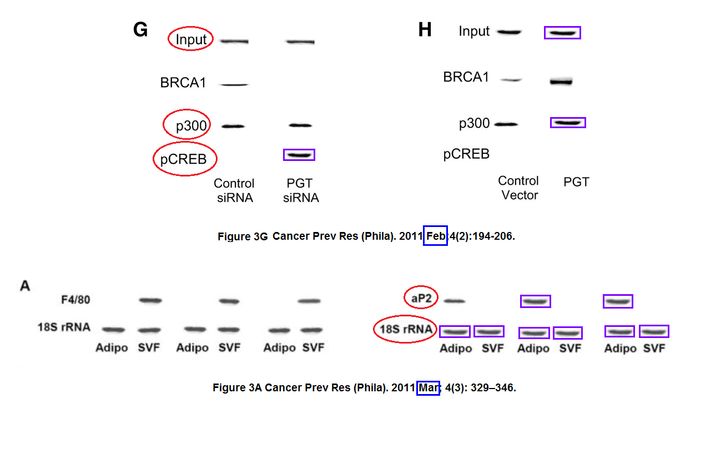
Several western blot bands were apparently cloned and copy pasted in two simultaneously published papers. Genius, this will sure push medicine forward. It is not like the lab improved its ethics since, this appeared just in 2015 in same Cancer Prevention Research:
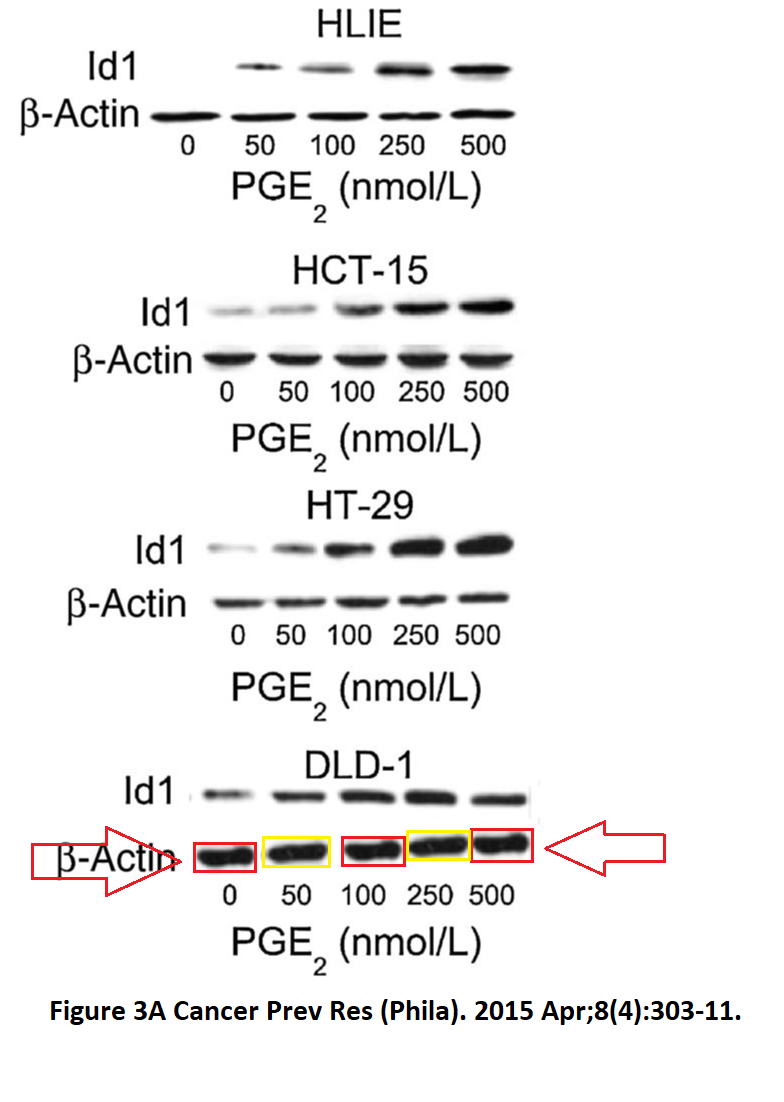
N Zhang , K Subbaramaiah , RK Yantiss , XK Zhou , Y Chin , R Benezra , AJ Dannenberg Id1 Deficiency Protects against Tumor Formation in Apc(Min/+) Mice but Not in a Mouse Model of Colitis-Associated Colon Cancer Cancer Prevention Research (2015) doi: 10.1158/1940-6207.capr-14-0411
Naturally, Dannenberg had nothing to do with all those bizarrely repetitive collages in the many papers from his own lab. Should the publisher AACR make any problems, he will maybe report those papers to Weill Cornell, as an experienced whistleblower.
Pier Paolo Pandolfi
There are other BCRF funded researchers with PubPeer records, but I would rather let you meet the real stars, the greatest men of science. Hence, fast forward to P, as Pier Paolo Pandolfi, Italian-born head of the Cancer Center in Harvard and as big a bigwig as one can be in cancer research. The man is so important and well-connected, that cancer patients get miraculously cured when his Cell paper is waved at them. Well, it sure works on his mice, and this is maybe why Pandolfi has around 30 papers discussed on PubPeer. These are some of them:
S Zhong , P Salomoni , S Ronchetti , A Guo , D Ruggero , PP Pandolfi Promyelocytic leukemia protein (PML) and Daxx participate in a novel nuclear pathway for apoptosis The Journal of Experimental Medicine (2000) doi: 10.1084/jem.191.4.631
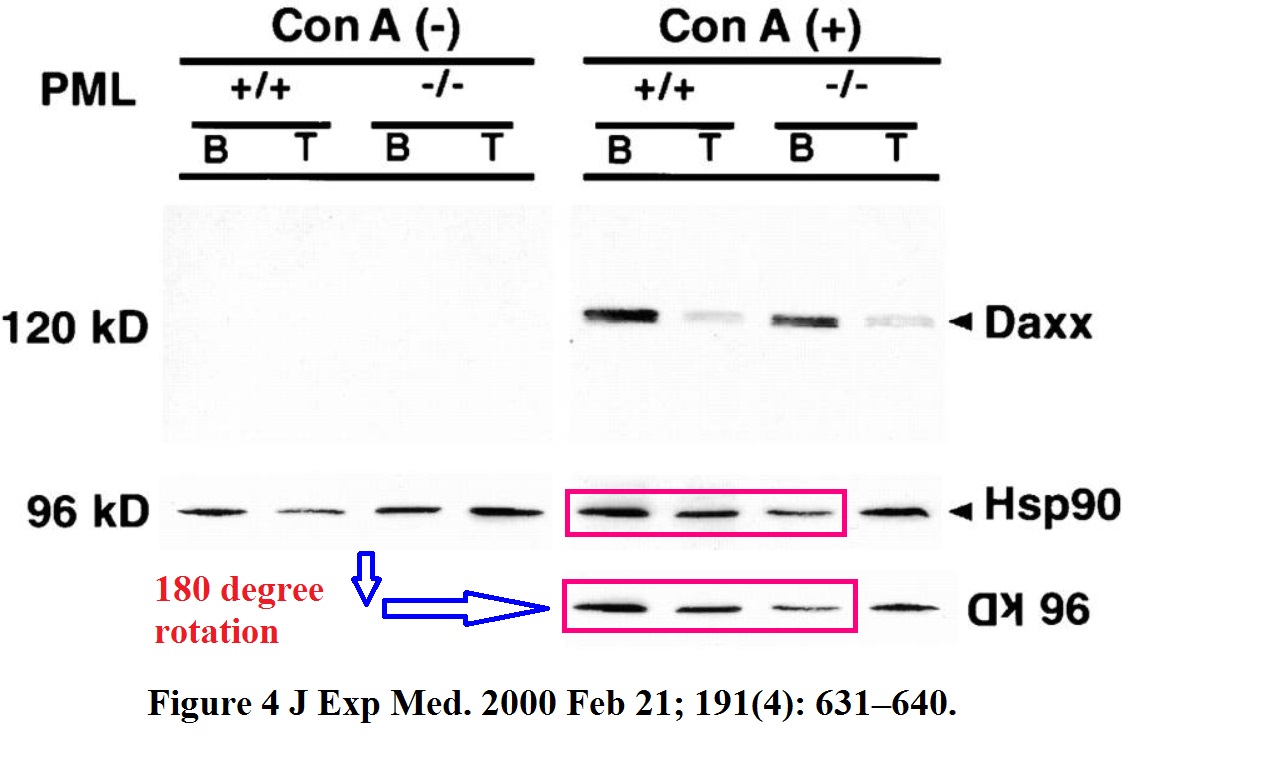
Someone inadvertently copy-pasted 3 bands, stretched them a bit, flipped them and stuck them onto another gel image. Happens daily. Another example of Harvard’s quality cancer research:
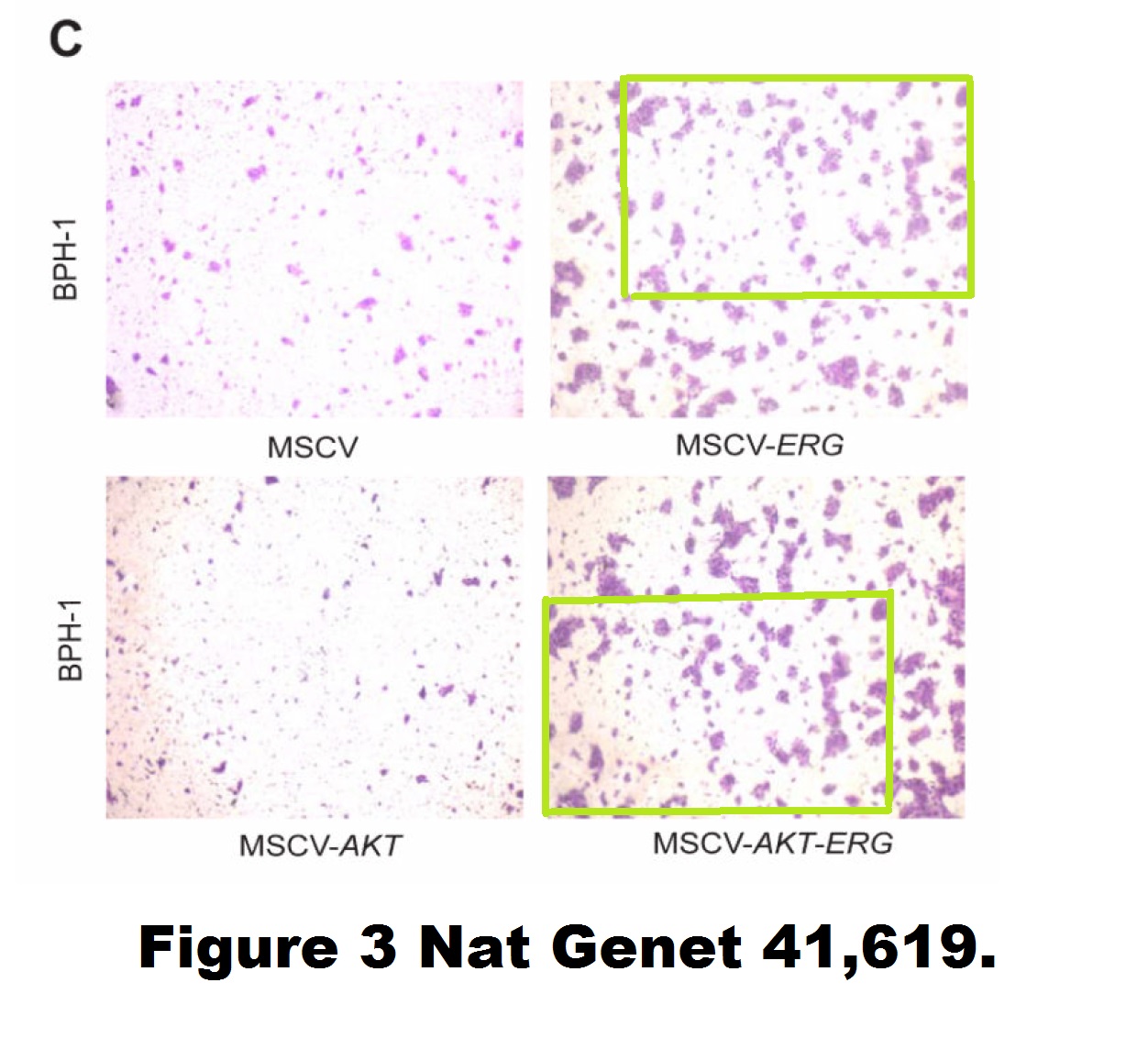
BS Carver , J Tran , A Gopalan , Z Chen , S Shaikh , A Carracedo , A Alimonti , C Nardella , S Varmeh , PT Scardino , C Cordon-Cardo , W Gerald , PP Pandolfi Aberrant ERG expression cooperates with loss of PTEN to promote cancer progression in the prostate Nature Genetics (2009) doi: 10.1038/ng.370
An image of a cell culture, copy-pasted and differently cropped by mistake of oversight to stand in for two different experiments. Not the only mistake in that paper. But the next case certainly cannot be important, because surely the respected National Academy of Sciences journal PNAS would have done something by now? Stop sniggering you all.
E. M. Rego , L.-Z. He , R. P. Warrell , Z.-G. Wang , P. P. Pandolfi Retinoic acid (RA) and As2O3 treatment in transgenic models of acute promyelocytic leukemia (APL) unravel the distinct nature of the leukemogenic process induced by the PML-RARalpha and PLZF-RARalpha oncoproteins Proceedings of the National Academy of Sciences (2000) doi: 10.1073/pnas.180290497
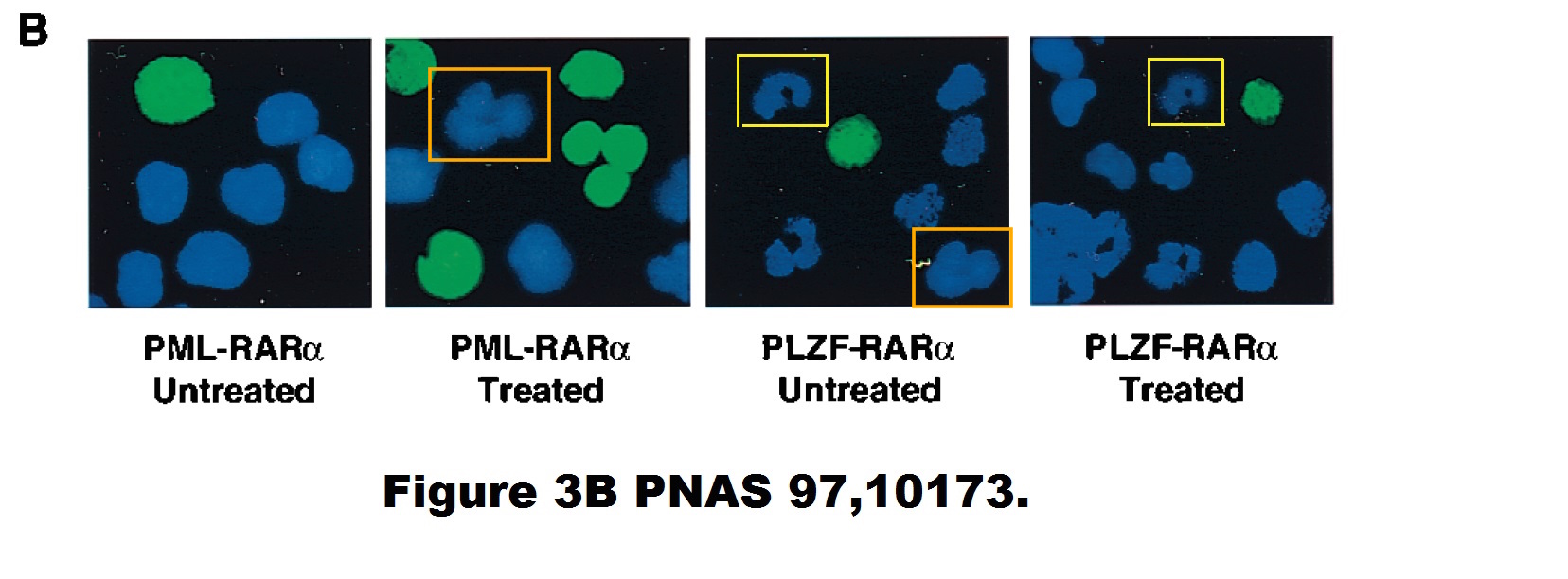
How can the same cell reappear in different images of physically different experiments? This is how Harvard, world’s leading university, cures cancer. Remember Pandolfi’s papers next time you are supposed to show reverence for that place. Btw, that was a “communicated” paper, meaning a friendly NAS member submitted it without proper peer review, but on endorsement from other friends. Which is another reason for PNAS not to touch it, because so many important people will be embarrassed.
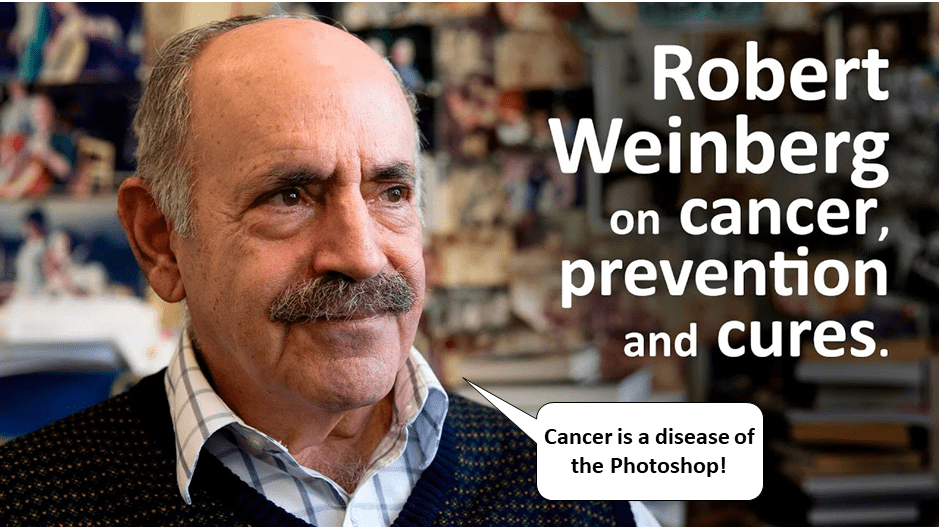
Robert “Bob” Weinberg
To conclude the parade, get ready to meet God. Robert Weinberg is director of the Ludwig Cancer Research Center at the Massachusetts Institute of Technology (MIT), another place which instils worshipping reverence in scientists around the world.
Weinberg is God of cancer research, and this means something in such a polytheistic religion as cancer research is. He is so important is that the only reason he has not received the Nobel Prize for curing cancer yet is because the Nobel would be a too small an award for his achievements. Weinberg is so respected by the scientific community that he is even allowed to submit manipulated data in his corrections.
Look at this, a seminal paper which proved where cancer really comes from. Turns out, it is a disease of the Photoshop:
A Rangarajan , SJ. Hong , A Gifford , RA. Weinberg Species- and cell type-specific requirements for cellular transformation Cancer Cell (2004) doi: 10.1016/j.ccr.2004.07.009 issn: 1535-6108

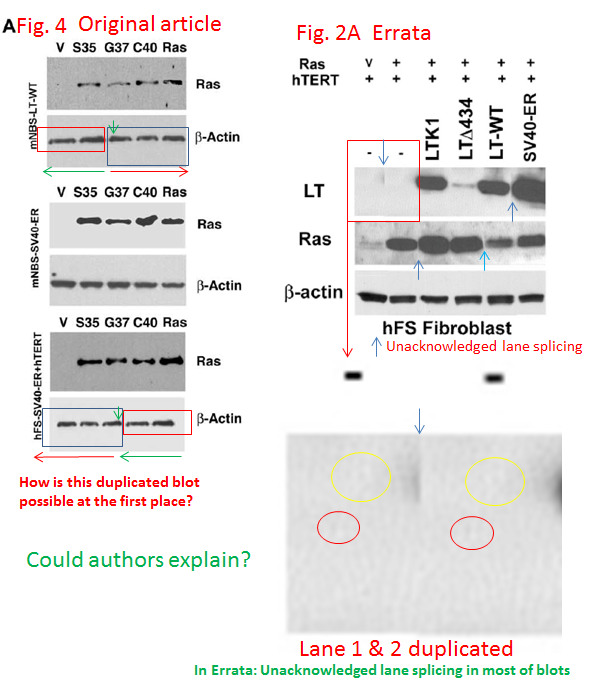

Weinberg, in his infinite wisdom, agreed with Cancer Cell in 2013 to remove some figures because they contained duplicated western blot bands. The new western blot figures are Photoshop-assembled collages which still contain duplicated bits. Other issues in that paper were ignored completely, like this here on the right.
What Weinberg was actually doing, was testing Cell Press’s faith in his divinity. The elite journal passed the Abrahamian test by sacrificing research integrity, and can be now seen as the true disciple of Weinberg and MIT. The publisher’s reward will be more papers with Weinberg’s name.
To be fair: Weinberg had to retract 5 papers since that correction, including in the flagship journal Cell. 4 of them share same first author: Scott Valastyan, someone once so successful and now so toxic that no record of his current whereabouts is available on the internet. Did any of that dent Weinberg’s reputation? Not really. Here what looks like a minor case of inappropriate gel splicing, but the PubPeer comment cited at the end puts it into perspective.
SA Mani , J Yang , M Brooks , G Schwaninger , A Zhou , N Miura , JL Kutok , K Hartwell , AL Richardson , RA Weinberg Mesenchyme Forkhead 1 (FOXC2) plays a key role in metastasis and is associated with aggressive basal-like breast cancers Proceedings of the National Academy of Sciences (2007) doi: 10.1073/pnas.0703900104
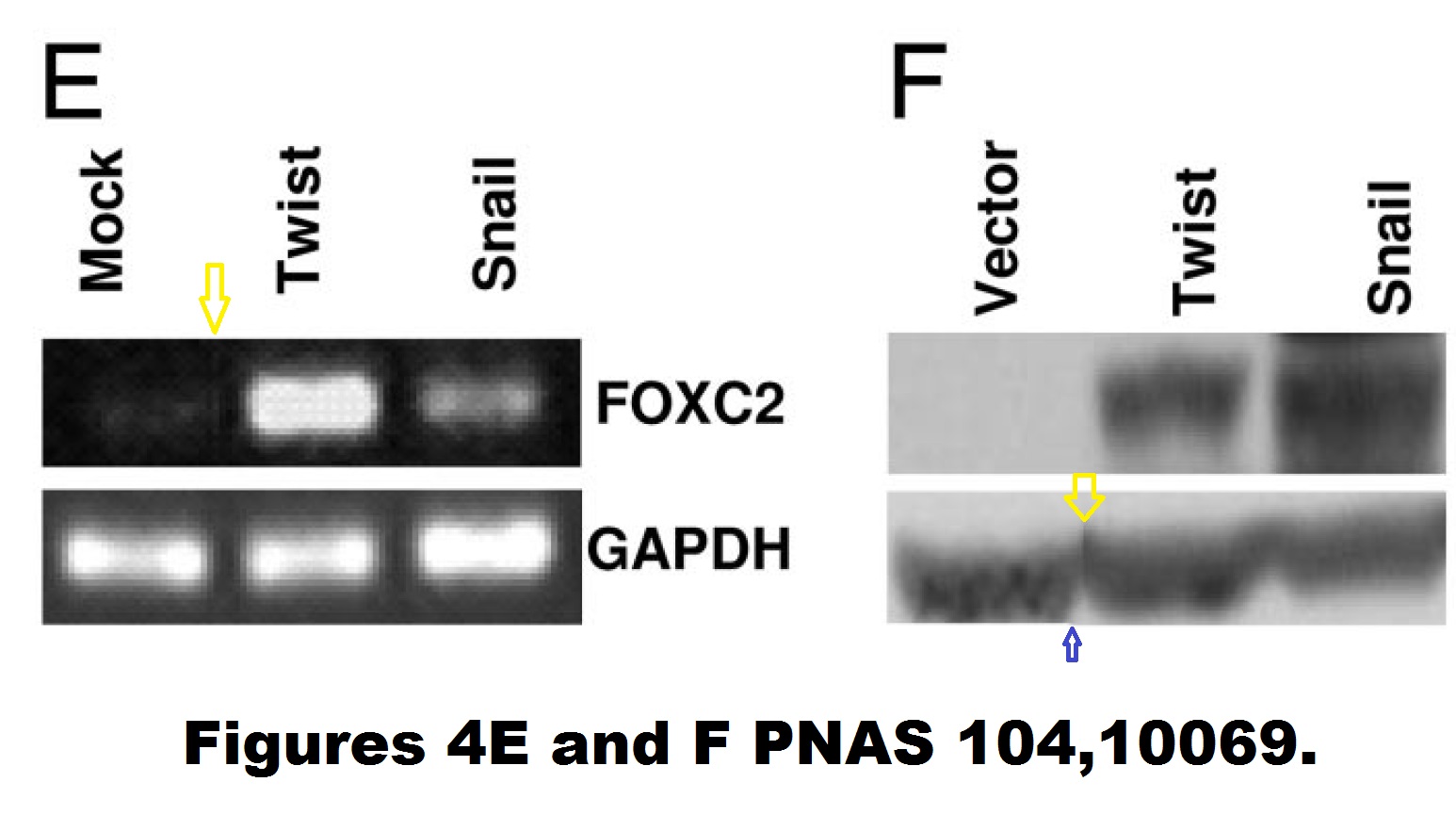
That PNAS paper was contributed by Weinberg himself, meaning he selected some friends as peer reviewers who did not mind the gel splicing. This was the PubPeer comment, already 5 years old:
“another one for the collection of Weinberg papers: https://pubpeer.com/search?q=Weinberg
and yes, splicing is widespread, everybody was/is/will be doing it, every paper was cited many times, why don’t we just accept it and move on. At the same time, a worryingly large proportion of studies (also and in particular in big journals) is not reproducible, so maybe these two developments are somehow connected.“

Donate!
If you are interested to support my work, you can leave here a small tip of $5. Or several of small tips, just increase the amount as you like (2x=€10; 5x=€25). Your generous patronage of my journalism will be most appreciated and remain confidential.
€5.00


I was at Cornell….you are still missing at least my ex-Boss and collaborators.
LikeLike
Another case from Harvard. Not clear what is the outcome of Harvard investigation as there were no discussions or retractions so far in any journals of the authors in question.
https://www.leagle.com/decision/infdco20190612707
LikeLike
How to diagnose and cure breast cancer in Emilia-Romagna, Italy where the proportion of patients with a successful outcome, in terms of survival after 5 years following diagnosis, reaches 89% (Data taken from: IX Rapporto nazionale “I numeri del cancro in Italia” curato da Associazione Italiana di Oncologia Medica e Associazione Italiana dei Registri Tumori).
LikeLike
Pingback: David Sabatini TORmented by steaming turds – For Better Science
To be fair on men there are some wizard women curing cancer in Photoshop.
https://pubpeer.com/publications/8507E12CC66CA1F853B1F05F139BFB
https://pubpeer.com/publications/A66D142101CB042AFA896E4FA36E71
https://pubpeer.com/publications/77A0668CA5430F5CBA0DD68ED9F6C6
https://pubpeer.com/publications/4567CB5D993557CFC4504CCD910C15
https://pubpeer.com/publications/B22EA7AC1D7FB6C80D90573A58711B
https://pubpeer.com/publications/781A905428A0F7A89C46E9FD414B65
LikeLike
Martine J Piccart should act locally as well as globally.
https://www.bcrf.org/researchers/martine-j-piccart-gebhart/
“Titles and Affiliations
Honorary Professor of Oncology
Université Libre de Bruxelles
Scientific Director
Institut Jules Bordet
Brussels, Belgium
Member, BCRF Scientific Advisory Board
She is co-founder and chair of the Breast International Group (BIG), uniting 57 academic research groups from around the world, running over 30 trials, and developing numerous research programs.”
Martine J Piccart, might pay attention closer to home, at the Institut Jules Bordet, of which she is the Scientific Director, and from which these relatively recent publications seem to emanate.
https://pubpeer.com/publications/CD226CEED8301F1FE317B6CCA13825
https://pubpeer.com/publications/81F319A1B0924676BFBC9616547DEC
https://pubpeer.com/publications/259C711B43B1BFCE4FED267E0D22C8
https://pubpeer.com/publications/D69A1269F9DA7306EC270F5C93E2F8
Quite extensive correction. Perhaps better retraction.
https://pubpeer.com/publications/BFC9C3EF61AEB27C46BC3473003342
Partial emanation.
https://pubpeer.com/publications/3B85F3DD94FE62A85FD0DE13382999
https://pubpeer.com/publications/5B56E64E20C1E9C4895F3247D0CA02
LikeLike
Pingback: George Iliakis, the pride of Ruhrgebiet – For Better Science
Pingback: "Daddy, we're afraid of you" – Life in Stu Aaronson's lab – For Better Science
Pingback: Amato Giaccia: too big to fall – For Better Science
Pingback: Pier Paolo Pandolfi out of Harvard, spotted in Italy and Nevada – For Better Science
Pingback: AACR conjures undead Count Fakula Michael Karin – For Better Science
“Andrew Dannenberg
Moving on to letter D we encounter a colleague of Cantley’s from Weill Cornell and an absolute star of Photoshop cancer research: Andrew Dannenberg. He now has 10 retractions because the no-nonsense Journal of Biological Chemistry (JBC) recently retracted 9 (NINE!) of his papers in one go. Dannenberg’s lawyer explained to Retraction Watch that their client had absolutely nothing to do with the experiments in the papers from his own lab. Weill Cornell added that they apparently see their professor as the actual whistleblower in this fraud affair. Of course there is more than the 9 retracted JBC papers…”
Cancer Prev Res (Phila). 2013 Sep;6(9):886-97. doi: 10.1158/1940-6207.CAPR-13-0140.
Dietary Polyphenols Suppress Elevated Levels of Proinflammatory Mediators and Aromatase in the Mammary Gland of Obese Mice
Kotha Subbaramaiah 1, Erika Sue, Priya Bhardwaj, Baoheng Du, Clifford A Hudis, Dilip Giri, Levy Kopelovich, Xi Kathy Zhou, Andrew J Dannenberg
Affiliation 1
Department of Medicine, Weill Cornell Medical College, 525 East 68th St, Room F-206, New York, New York 10065, USA. ksubba@med.cornell.edu
https://pubpeer.com/publications/B4E5C2E109EAAAEBBD0D2891C9054A
Problematic data. Much more similar than expected within each figure below.
Figure 1D.
Figure 2D.
Figure 3D.
Figure 6C.
LikeLike
Dannenberg defence,
https://retractionwatch.com/2020/01/03/prominent-cancer-researcher-loses-eight-papers-making-11/
Dannenberg referred us to Weill media officials and his attorney, Bruce Singal, who specializes in research misconduct cases at the Boston firm of Barrett & Singal. Singal told us that Dannenberg:
“is cooperating fully, both with the JBC and with Weill Cornell, in making sure they get to the bottom of this. He certainly had nothing to do with generating the experiments [with the falsified data] and he had every reason to believe that the data were truthful and reliable.”
“is cooperating fully” has a familiar ring to it.
or is it plea bargaining?
Clifford C Hudis is co-author on several AJ Dannenberg papers
https://pubpeer.com/search?q=hudis
including 2 retracted ones,
https://pubpeer.com/publications/B2D5C949A6BED893D5AC03AFD59C09
https://pubpeer.com/publications/2AE4366209B0FA47B0B3FD3636DA39
and one with an Expression of Concern.
https://pubpeer.com/publications/A0D814C531ABFB80B7E743422102A3
The American Society of Clinical Oncology does not bat an eyelid.
https://www.asco.org/people/clifford-a-hudis-md
“Dr. Hudis is the Chief Executive Officer of the American Society of Clinical Oncology (ASCO).”
“Dr. Hudis is responsible for delivering on the board’s strategic goals through education, research, and support for the delivery of the highest quality of care by the Society’s nearly 45,000 members.”
In fact, the American Society of Clinical Oncology has put him in charge of research.
It’s never as bad as you think, but worse.
LikeLike
Pingback: Whom to sacrifice for Human Challenge Trials? – For Better Science
Pingback: How USA embraced research fraud: review of two books – For Better Science
Pingback: mTOR: conclusions not affected? – For Better Science
Pingback: Spandidos and the Paper Mill – For Better Science
“Andrew Dannenberg
Moving on to letter D we encounter a colleague of Cantley’s from Weill Cornell and an absolute star of Photoshop cancer research: Andrew Dannenberg.”
2021 retraction for: Cancer Discov . 2012 Apr;2(4):356-65. doi: 10.1158/2159-8290.CD-11-0241. Epub 2012 Jan 27.
Increased levels of COX-2 and prostaglandin E2 contribute to elevated aromatase expression in inflamed breast tissue of obese women
Kotha Subbaramaiah 1, Patrick G Morris, Xi Kathy Zhou, Monica Morrow, Baoheng Du, Dilip Giri, Levy Kopelovich, Clifford A Hudis, Andrew J Dannenberg Affiliations expand
PMID: 22576212 PMCID: PMC3398487 DOI: 10.1158/2159-8290.CD-11-0241
2021 retraction. https://cancerdiscovery.aacrjournals.org/content/11/5/1306
This article (1) has been retracted at the request of the authors based upon evidence of data falsification or fabrication in Figs. 2B, 4C, and 5H. An Editor’s Note had previously been issued (2). A copy of this Retraction Notice was sent to the last known e-mail addresses for the 9 authors. Eight authors (Kotha Subbaramaiah, Patrick G. Morris, Xi Kathy Zhou, Monica Morrow, Dilip Giri, Levy Kopelovich, Clifford A. Hudis, and Andrew J. Dannenberg) agreed to the retraction; one author (Baoheng Du) did not respond. The authors apologize to the scientific community and deeply regret any inconveniences or challenges resulting from the publication and subsequent retraction of this article.
References 1.↵Subbaramaiah K, Morris PG, Zhou XK, Morrow M, Du B, Giri D, et al. Increased levels of COX-2 and prostaglandin E2 contribute to elevated aromatase expression in inflamed breast tissue of obese women. Cancer Discov 2012;2:356–65.
2.↵Editor’s Note: Increased levels of COX-2 and prostaglandin E2 contribute to elevated aromatase expression in inflamed breast tissue of obese women. Cancer Discov 2019;9:1142.
LikeLike
Dannenberg’s institutional website at Weill Cornell is retracted also. Last backup from February 2020.
Turns out, he retired on March 30, 2021:
Aged merely 65…
LikeLike
9 more retractions for Andrew J Dannenberg.
1st June 2022
https://aacrjournals.org/cancerpreventionresearch/issue/15/6
Retractions
Retraction: Id1 Deficiency Protects Against Tumor Formation in ApcMin/+ Mice but not in a Mouse Model of Colitis-associated Colon Cancer
Ning Zhang; Kotha Subbaramaiah; Rhonda K. Yantiss; Xi Kathy Zhou; Yvette Chin; Robert Benezra; Andrew J. Dannenberg
Retraction: p53 Modulates Hsp90 ATPase Activity and Regulates Aryl Hydrocarbon Receptor Signaling
Amit Kochhar; Levy Kopelovich; Erika Sue; Joseph B. Guttenplan; Brittney-Shea Herbert; Andrew J. Dannenberg; Kotha Subbaramaiah
Retraction: Dietary Polyphenols Suppress Elevated Levels of Proinflammatory Mediators and Aromatase in the Mammary Gland of Obese Mice
Kotha Subbaramaiah; Erika Sue; Priya Bhardwaj; Baoheng Du; Clifford A. Hudis; Dilip Giri; Levy Kopelovich; Xi Kathy Zhou; Andrew J. Dannenberg
Retraction: Caloric Restriction Reverses Obesity-Induced Mammary Gland Inflammation in Mice
Priya Bhardwaj; Baoheng Du; Xi Kathy Zhou; Erika Sue; Michael D. Harbus; Domenick J. Falcone; Dilip Giri; Clifford A. Hudis; Levy Kopelovich; Kotha Subbaramaiah; Andrew J. Dannenberg
Retraction: Pioglitazone, a PPARγ Agonist, Suppresses CYP19 Transcription: Evidence for Involvement of 15-Hydroxyprostaglandin Dehydrogenase and BRCA1
Kotha Subbaramaiah; Louise R. Howe; Xi Kathy Zhou; Peiying Yang; Clifford A. Hudis; Levy Kopelovich; Andrew J. Dannenberg
Retraction: Carnosol, a Constituent of Zyflamend, Inhibits Aryl Hydrocarbon Receptor-Mediated Activation of CYP1A1 and CYP1B1 Transcription and Mutagenesis
Arash Mohebati; Joseph B. Guttenplan; Amit Kochhar; Zhong-Lin Zhao; Wieslawa Kosinska; Kotha Subbaramaiah; Andrew J. Dannenberg
Retraction: Obesity Is Associated With Inflammation and Elevated Aromatase Expression in the Mouse Mammary Gland
Kotha Subbaramaiah; Louise R. Howe; Priya Bhardwaj; Baoheng Du; Claudia Gravaghi; Rhonda K. Yantiss; Xi Kathy Zhou; Victoria A. Blaho; Timothy Hla; Peiying Yang; Levy Kopelovich; Clifford A. Hudis; Andrew J. Dannenberg
Retraction: The Prostaglandin Transporter Regulates Adipogenesis and Aromatase Transcription
Kotha Subbaramaiah; Clifford A. Hudis; Andrew J. Dannenberg
Retraction: HSP90 Inhibitors Suppress Aryl Hydrocarbon Receptor–Mediated Activation of CYP1A1 and CYP1B1 Transcription and DNA Adduct Formation
Duncan Hughes; Joseph B. Guttenplan; Craig B. Marcus; Kotha Subbaramaiah; Andrew J. Dannenberg
LikeLike
Good work.
LikeLike
Dannenberg was retired last year,
and now Kotha Subbaramaiah’ institutional profile is also gone. Some retraction notices mention a Weill Cornell investigation where he got blamed for forgery.
LikeLike
https://retractionwatch.com/2022/06/03/former-weill-cornell-cancer-researcher-up-to-20-retractions-investigations-findings-are-with-feds/
LikeLike
Pingback: Pier Paolo Pandolfi shrouded in Turin! – For Better Science
“Robert “Bob” Weinberg”
It is rumoured (Sweden has a small population) that the Nobel Committee for Physiology or Medicine has decided that Robert Weinberg will not receive a Nobel Prize because of his 5 retractions.
http://retractiondatabase.org/RetractionSearch.aspx#?auth%3dWeinberg%252c%2bRobert%2bA
If Gregg Semenza reaches 5 retractions would it be fair to retract his Nobel Prize?
https://forbetterscience.com/2020/10/07/gregg-semenza-real-nobel-prize-and-unreal-research-data/
LikeLike
Gregg Semenza 9 retractions in total.
http://retractiondatabase.org/RetractionSearch.aspx#?auth%3dSemenza%252c%2bGregg%2bL
Truly pioneering work! A trailblazer, who has lowered the bar!
LikeLike
Pingback: The Legacy of Joan Massague – For Better Science
Pingback: Bert Vogelstein and Heiko Hermeking mull lawsuits – For Better Science